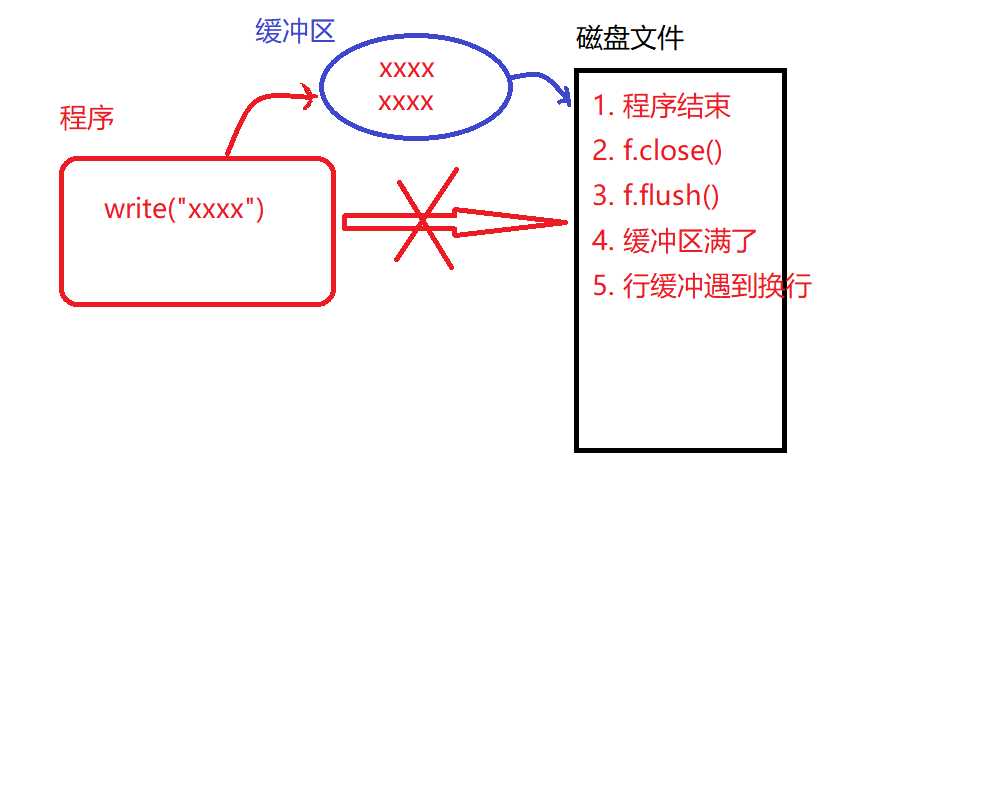标签:字符串 readlines 打开方式 sci 获取文件 codeblock 输出 div key
1.定义:在内存中存在数据交换的操作认为是IO操作,比如和终端交互 ,和磁盘交互,和网络交互等
2.程序分类:
定义:文件是保存在持久化存储设备(硬盘、U盘、光盘..)上的一段数据。从功能角度分为文本文件(打开后会自动解码为字符)、二进制文件(视频、音频等)。在Python里把文件视作一种类型的对象,类似之前学习过的其它类型。
在python3中引入了字节串的概念,与str不同,字节串以字节序列值表达数据,更方便用来处理二进程数据。因此在python3中字节串是常见的二进制数据展现方式。
对文件实现读写的基本操作步骤为:打开文件,读写文件,关闭文件
file_object = open(file_name, access_mode=‘r‘, buffering=-1) 功能:打开一个文件,返回一个文件对象。 参数:file_name 文件名; access_mode 打开文件的方式,如果不写默认为‘r’ 文件模式 操作 r 以读方式打开 文件必须存在 w 以写方式打开 文件不存在则创建,存在清空原有内容 a 以追加模式打开 r+ 以读写模式打开 文件必须存在 w+ 以读写模式打开文件 不存在则创建,存在清空原有内容 a+ 以读写模式打开 追加模式 rb 以二进制读模式打开 同r wb 以二进制写模式打开 同w ab 以二进制追加模式打开 同a rb+ 以二进制读写模式打开 同r+ wb+ 以二进制读写模式打开 同w+ ab+ 以二进制读写模式打开 同a+ buffering 1表示有行缓冲,默认则表示使用系统默认提供的缓冲机制。 返回值:成功返回文件操作对象。
缓冲:系统自动的在内存中为每一个正在使用的文件开辟一个缓冲区,从内存向磁盘输出数据必须先送到内存缓冲区,再由缓冲区送到磁盘中去。从磁盘中读数据,则一次从磁盘文件将一批数据读入到内存缓冲区中,然后再从缓冲区将数据送到程序的数据区。

1 # 打开文件 2 try: 3 fd = open(‘img.jpg‘,‘ab+‘) 4 except FileNotFoundError as e: 5 print(e) 6 7 # 开始你的读写 8 9 # 关闭文件 10 fd.close()
1.读取文件
read([size])
功能: 用来直接读取文件中字符。
参数: 如果没有给定size参数(默认值为-1)或者size值为负,文件将被读取直至末尾,给定size最多读取给定数目个字符(字节)。
返回值: 返回读取到的内容

1 # 打开文件 2 f = open(‘test‘,‘r‘) 3 4 # read循环读取文件 5 while True: 6 # 一次最多读取1024字节 7 data = f.read(1024) 8 # 读到文件结尾得到空字符串,此时跳出循环 9 if not data: 10 break 11 print("读取的内容:",data)
readline([size])
功能: 用来读取文件中一行
参数: 如果没有给定size参数(默认值为-1)或者size值为负,表示读取一行,给定size表示最多读取制定的字符(字节)。
返回值: 返回读取到的内容

1 # 打开文件 2 f = open(‘test‘,‘r‘) 3 4 # 读取一行内容 5 data = f.readline() 6 print("读取的内容:",data) 7 data = f.readline() 8 print("读取的内容:",data)
readlines([sizeint])
功能: 读取文件中的每一行作为列表中的一项
参数: 如果没有给定size参数(默认值为-1)或者size值为负,文件将被读取直至末尾,给定size表示读取到size字符所在行为止。
返回值: 返回读取到的内容列表

1 # 打开文件 2 f = open(‘test‘,‘r‘) 3 4 # 读取所有内容,每行作为列表中一个元素 5 data = f.readlines() 6 print("读取的内容:",data)
文件对象本身也是一个可迭代对象,在for循环中可以迭代文件的每一行。

1 # 打开文件 2 f = open(‘test‘,‘r‘) 3 # 每次获取文件一行 4 for line in f: 5 print(line)
2.写入文件
write(string)
功能: 把文本数据或二进制数据块的字符串写入到文件中去
参数:要写入的内容

1 # w原有内容被清除,a则追加 2 #f = open(‘test‘,‘a‘) 3 f = open(‘test‘,‘wb‘) 4 # 如果是wb打开要转换为字节串写入 5 f.write("hello word\n".encode()) 6 f.write("python".encode()) 7 8 f.close()
writelines(str_list)
功能:接受一个字符串列表作为参数,将它们写入文件。
参数: 要写入的内容列表

1 # w原有内容被清除,a则追加 2 f = open(‘test‘,‘a‘) 3 4 f.writelines([‘abc\n‘,‘def\n‘]) 5 6 f.close()
3.关闭文件
打开一个文件后我们就可以通过文件对象对文件进行操作了,当操作结束后使用close()关闭这个对象可以防止一些误操作,也可以节省资源。
file_object.close()
4.with操作
python中的with语句使用于对资源进行访问的场合,保证不管处理过程中是否发生错误或者异常都会执行规定的“清理”操作,释放被访问的资源,比如有文件读写后自动关闭、线程中锁的自动获取和释放等。
with语句的语法格式如下:
with context_expression [as target(s)]:
with-body
通过with方法可以不用close(),因为with生成的对象在语句块结束后会自动处理,所以也就不需要close了,但是这个文件对象只能在with语句块内使用。

1 with open(‘file‘,‘r+‘) as f: 2 f.read() 3 等同于---------------------- 4 f=open(‘file’,‘r+’) 5 f.read() 6 f.close()
注意:
练习:读取dict文件,并输入单词获取单词的含义

a indef art one abandonment n. abandoning abashed adj. ~ embarrassed; ashamed abate v. make or become less abattoir n. = slaughterhouse (slaughter) abbess n. woman who is head of a convent or nunnery abbot n. man who is head of a monastery or abbey abbreviate v. ~ sth shorten (a word, phrase, etc), esp by omitting letters abbreviation n. abbreviating or being abbreviated abdicate v. resign from or formally renounce the throne abdication giving up control, authority abdominal adj. in, of or for the abdomen abduct v. take away illegally, using force or deception; kidnap ; abduction A carrying away of a person against his will, or illegally. abed In bed; on a bed. aberrant adj. not following the normal or correct way aberration n. deviation from what is accepted as normal or right abhor v. feel hatred and disgust for (sb/sth); detest abhorrence n. hatred and disgust profligacy n. being profligate profligate adj. recklessly extravagant or wasteful profound adj. deep, intense or far-reaching; verygreat profoundly adv. deeply; extremely profundity n. depth (esp of knowledge, thought, etc) profuse adj. in large amounts; abundant profusion n. ~ of sth abundant supply of sth progenitor n. ancestor (of a person, an animal or a plant) progeny n. offspring prognosticate v. tell (sth) in advance; predict

1 word = input("Word:") 2 3 # 默认r打开 4 f = open("dict.txt") 5 6 for line in f: 7 tmp = line.split(‘ ‘)[0] 8 # 遍历的单词已经大于目标 9 if tmp > word: 10 print("没有找到该单词") 11 break 12 elif tmp == word: 13 print(line) 14 break 15 else: 16 print("没有找到该单词") 17 18 f.close()

flush()
该函数调用后会进行一次磁盘交互,将缓冲区中的内容写入到磁盘。

1 """ 2 缓冲区 3 """ 4 5 # 1表示行缓冲 6 f = open(‘test‘,‘w‘,1) 7 8 while True: 9 s = input(">>") 10 f.write("nihao\n") 11 # f.flush() # 将缓冲内容写入磁盘 12 13 f.close()
1.定义::打开一个文件进行操作时系统会自动生成一个记录,记录中描述了我们对文件的一系列操作。其中包括每次操作到的文件位置。文件的读写操作都是从这个位置开始进行的。
2.基本操作
tell()
功能:获取文件偏移量大小
seek(offset[,whence])
功能:移动文件偏移量位置
参数:offset 代表相对于某个位置移动的字节数。负数表示向前移动,正数表示向后移动。
whence是基准位置的默认值为 0,代表从文件开头算起,1代表从当前位置算起,2 代表从文件末尾算起。

1 # r,w打开文件偏移量在开头 2 # a打开文件偏移量在结尾 3 f = open(‘test‘,‘wb+‘) 4 5 f.write(b"hello\n") 6 f.flush() 7 8 print(f.tell()) #打印当前文件偏移量 9 f.seek(-3,2) # 以开头为基准向后移动0字节 10 11 data = f.read() 12 print(data)

1 f = open(‘test‘,‘wb‘) 2 3 f.write(b‘start‘) 4 f.seek(1000,2) # 结尾位置向后移动1000字节 5 f.write(b‘end‘) 6 7 f.close()
1.定义:系统中每一个IO操作都会分配一个整数作为编号,该整数即这个IO操作的文件描述符。
2.获取文件描述符
fileno()
通过IO对象获取对应的文件描述符
1.获取文件大小:os.path.getsize(file)
2.查看文件列表:os.listdir(dir)
3.查看文件是否存在:os.path.exists(file)
4.判断文件类型:os.path.isfile(file)
5.删除文件:os.remove(file)
练习1:向一个文件写入日志, 写入格式:
1. 2019-1-1 12:12:12
2. 2019-1-1 12:12:13
3. 2019-1-1 12:12:24
要求每隔1秒写入一次,每条时间占一行.程序死循环,crtl-c退出. 如果程序退出重新启动时内容能跟上次内容衔接(序列号)

1 import time 2 3 f = open(‘log.txt‘,‘a+‘) 4 5 n = 0 6 f.seek(0,0) # 将偏移量移动待开始然后计数 7 for line in f: 8 n += 1 9 10 while True: 11 n += 1 12 time.sleep(1) 13 s = "%d. %s\n"%(n,time.ctime()) 14 f.write(s) 15 f.flush() # 随时看到文件变化
练习2:从终端输入一个文件名称(包含路径),如果该文件存在则将该文件复制到当前目录下,命名为1904(要求文件可以是任意类型),如果文件不存在则打印该文件不存在

1 # 输入文件名 2 filename = input("File:") 3 4 try: 5 fr = open(filename,‘rb‘) 6 except FileNotFoundError as e: 7 print(e) 8 else: 9 fw = open(‘file.jpg‘,‘wb‘) 10 11 # 循环复制 12 while True: 13 data = fr.read(1024) 14 if not data: 15 break 16 fw.write(data) 17 18 fr.close() 19 fw.close()
标签:字符串 readlines 打开方式 sci 获取文件 codeblock 输出 div key
原文地址:https://www.cnblogs.com/maplethefox/p/10988858.html